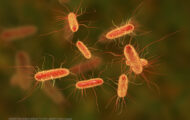Three multi-state Salmonella outbreaks were linked to contact with live animals in 2013, two from live chicks and one from illegal pet turtles. A total of 987 people were sickened in these three outbreaks, most of them were children.
 The outbreak associated with pet turtles sickened 473 people in 41 states, the District of Columbia, and Puerto Rico. The Centers for Disease Control and Prevention (CDC) described the outbreak as a series of overlapping outbreaks that began in May 2011 and ended October 2013.
The outbreak associated with pet turtles sickened 473 people in 41 states, the District of Columbia, and Puerto Rico. The Centers for Disease Control and Prevention (CDC) described the outbreak as a series of overlapping outbreaks that began in May 2011 and ended October 2013.
Seventy percent of those sickened were 10 years old or younger, 31 percent were 1 year old or younger. Forty four percent of the case patients were of Hispanic ethnicity. About 29 percent were of those sickened required hospitalization, no deaths were reported.
By state, the case count was as follows: Alabama (4), Alaska (2), Arizona (27), Arkansas (4), California (106), Colorado (6), Connecticut (1), Delaware (4), Florida (1), Georgia (10), Illinois (10), Indiana (1), Kansas (2), Kentucky (3), Louisiana (5), Maine (1), Maryland (17), Massachusetts (12), Michigan (5), Minnesota (1), Mississippi (4), Missouri (4), Nevada (11), New Jersey (26), New Mexico (15), New York (55), North Carolina (3), Ohio (6), Oregon (1), Pennsylvania (34), Puerto Rico (1), Rhode Island (1), South Carolina (17), South Dakota (1), Tennessee (7), Texas (45), Utah (1), Vermont (1), Virginia (5), Washington (5), Washington, D.C. (3), Wisconsin (2) and West Virginia (3).
Children are among those who at particular risk when it comes to Salmonella infection, which is why the Food and Drug Administration (FDA) banned the sale and distribution of small turtles as pets in 1975. Turtles with shells shorter four inches are illegal to own.
The FDA and state public health and agriculture agencies traced the origin of the illegal turtles sold in Florida shops to two turtle farms in Louisiana. The Louisiana Department of Agriculture and Forestry issued these farms cease and desist orders in March 2013, so they are no longer selling turtles with a shell length of less than four inches domestically. The source of turtles in other outbreaks could not be identified because many were sold by street vendors.
In the first outbreak associated with live poultry, 158 people were sickened by one of four outbreak strains: Salmonella Infantis, Salmonella Lille, Salmonella Newport, or Salmonella Mbandaka. Illnesses from contact with live chicks or ducks were reported from 30 states, 41 percent of those sickened were children 10 years of age or younger. Twenty nine people were hospitalized.Epidemiologic, laboratory, and traceback investigations linked the outbreak to Mt. Healthy Hatcheries in Ohio.
In the second outbreak, 356 people in 39 states were sickened, 62 were hospitalized. About 57 percent of those sickened were children 10 years of age or younger.
Traceback investigations identified 18 mail-order hatcheries that supplied poultry to feed stores where the poultry was purchased. Privett Hatchery in Portales, New Mexico was identified as a major source of poultry linked to this outbreak.
Mail-order hatcheries, agricultural feed stores, and other companies that sell live poultry should provide health-related information to owners and potential buyers, including information about the risk of Salmonella. Anyone handling live poultry, or anything in the area where they live and roam, should wash hands thoroughly with soap and water right afterwards. Live poultry should not be allowed inside the house.




